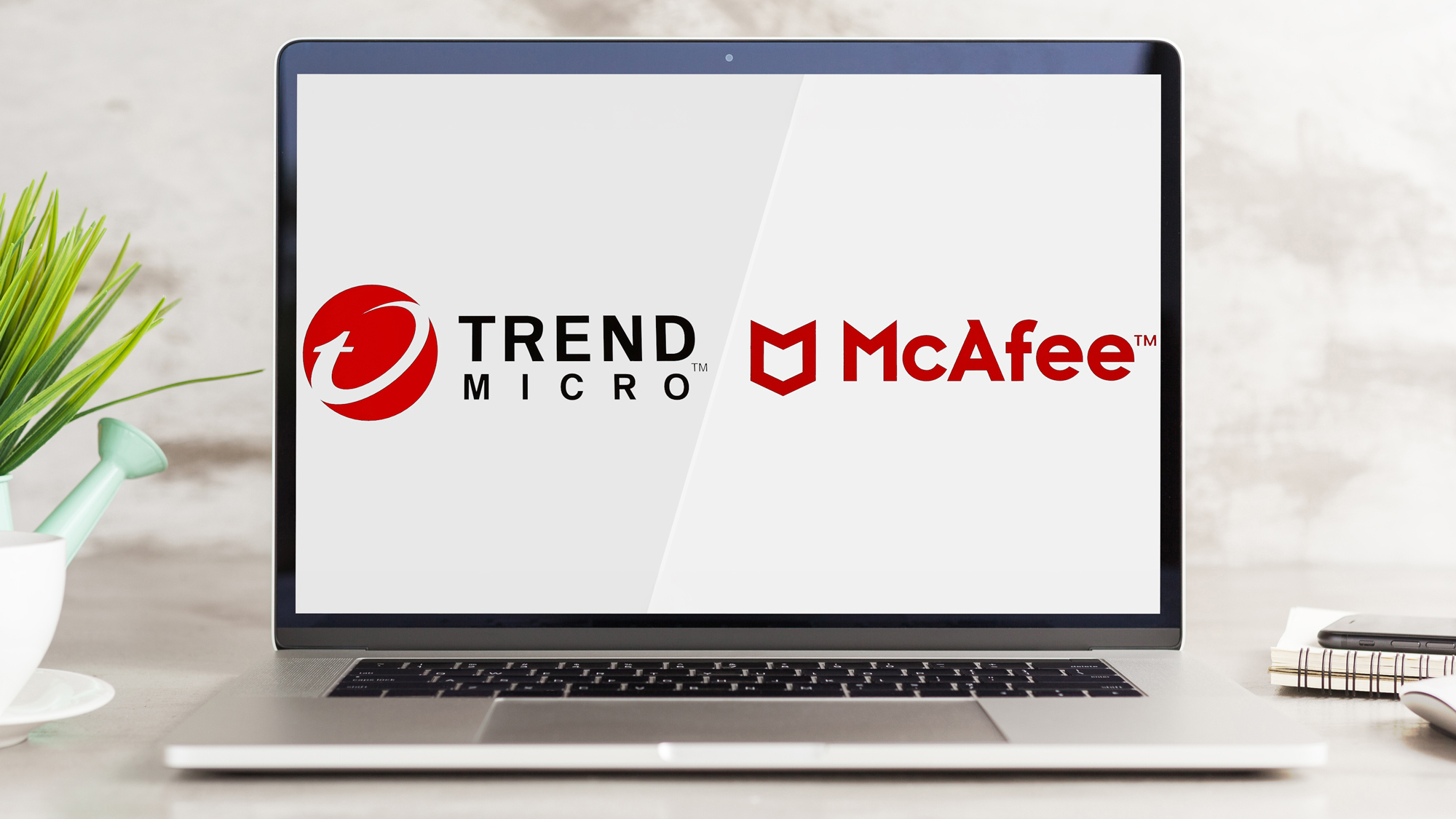Trend Micro Trend Micro is our top antivirus choice for those who prioritize banking needs for a few reasons: It offers a secure browser for online shopping, it has protection against phishing, tech-support scans and crypto-mining malware and comes with file encryption and file shredding. McAfee antivirus McAfee+ Ultimate is ideal for those looking to cover large families with a wide variety of devices. The plan has support for all the major computing platforms, and every plan is essentially "unlimited" in that it offers that many licenses.
There's good protection against malware, an easy to learn interface and features you'd expect to see like a VPN (for up to five) and a password manager. First, we compared Bitdefender versus Norton. Next we put Norton versus McAfee in a head-to-head roundup.

Now, we're putting McAfee versus Trend Micro into a comparison to see, point by point, how the two antivirus software programs match up against each other.Which one offers more features? Which one covers more devices or has more plans? Which one produced more false positives in testing? Which one takes up fewer system resources?While both of software suites are among the best antivirus software you can get today and are good at protecting your computer from viruses and malware, those aren't the only factors you're going to take into account when it comes to determining which program you want on your PC.Like our roundups before it, this McAfee versus Trend Micro comparison is written so that you can make a choice between these two top antivirus software options.
Trend Micro vs McAfee: SpecsTrend Micro vs McAfee: Costs and what’s covered(Image credit: Tom's Guide)Neither McAfee nor Trend Micro offers a free tier, though both offer a free 30-day trial. Trend Micro's entry-level Antivirus + Security tier costs $40 and includes a Mute Mode and Pay Guard secure browser; it can often be found online for half off. McAfee's Basic plan retails for $90 for a single device but can often be found for a more reasonable $25.
That Basic plan gets you its antivirus program as well as features like a firewall, password manager, file shredder, and VPN (for one user) for use with a Windows, Mac, Android or iOS device. Trend Micro's Antivirus + Security covers a single Windows computer only.Each suite has a variety of paid tiers that go from there: Trend Micro's next step up is Internet Security which covers three Windows computers for $80 and includes protection against ransomware and email scams, as well as parental controls, a social media scanner and a system optimizer.
The $90 Maximum Security package will protect five systems and throws in a password manager, while Premium Security will cover ten systems, and has a VPN (for five users) as well as dark web scanning but will cost you $150.McAfee tiers up from the $60 McAfee+, to McAfee+ Premium which has Individual or Family plans ranging from $70 to $150 and can cover up to 2 adults and 4 children. There's also McAfee + Advanced which is focused on identity theft protection and can be found for $90 or $120 for an Individual or Family plan.
At the top of the tier is Ultimate, which isn't usually found for less than $250. McAfee's Privacy & Identity Guard is an additional service which can be found for $100.Winner: McAfeeTrend Micro vs McAfee: Antivirus Protection(Image credit: Tom's Guide)Trend Micro's antivirus plans all scan for known malware and will monitor your system using heuristic behavioral analysis to spot early signs of an attack.
The software also has dedicated defenses against phishing, cryptocurrency-mining malware, ransomware, tech-support scams and fileless malware.McAfee's products use a cloud-based infrastructure with an emphasis on machine learning to catch dangerous code early. The malware scanner on the software sends potential new threats to McAfee's servers for analysis and - unlike other programs - you can't opt out.
If Trend Micro's heuristic behavioral analysis notices anything suspicious, it will get uploaded to the company's labs for further identification and examination. However, if you feel like this is too much information to send, you can opt out of this data collection via the online portal. Each system protected by Trend Micro software gets periodic downloads of new malware signatures, sometimes several times a day.
McAfee's Ransom Guard feature will lookout for any suspicious file changes and if it sees them, it can quickly make copies of targeted files in case of an attack. The Advanced Malware Detection speeds up the detection of any problems and McAfee can also remotely clean the system - however, this service is only included if you have auto renewal activated. There's no rescue disk available.
(Image credit: Tom's Guide)Trend Micro also has a PC Health Checkup feature that will optimize your system while highlighting any vulnerabilities, as well as a Fraud Buster feature which uses AI to warn about any scams hidden in emails. The Fraud Buster also has a browser extension to advise about malicious websites. And there's a Rescue Disk that can be downloaded to help recover a system overwhelmed with malware.
McAfee has multiple reports: one that can be run for antivirus and one for firewall. They're provided weekly, monthly or annually with data on the program's activities. The antivirus report details threats and attacks as well as how many of the systems files have been scanned; while the firewall report explains what's being monitored and blocked.
Winner: TieTrend Micro vs McAfee: Antivirus Performance In AV Comparative’s Real-World Protection Test July-October 2024, McAfee scored a 99.8% protection rate while Trend Micro scored 98.1%.
This is because McAfee along with Avira, F-Secure and Norton blocked all but one of the 471 malicious code samples the testing lab used in their analysis. Meanwhile, Trend Micro blocked 462 samples with nine slipping past its defenses.(Image credit: Tom's Guide)McAfee continued to perform well in AV Comparative's false positive tests with just 10 which put its antivirus towards the middle of the pack.
Unfortunately for Trend Micro though, it ended this test at the very bottom with a total of 76 false positives.McAfee also saw solid results in SE Labs’ Endpoint Protection Home 2024 Q4 tests with a perfect accuracy rating of 100%. Trend Micro no longer participates in this lab’s testing though, so we can’t compare the results of both antivirus products here.
Winner: McAfeeTrend Micro vs McAfee: Security and Privacy FeaturesThough Trend Micro does not include a firewall, it does have a Firewall Booster feature that monitors web traffic for evidence of intrusion and botnets. And all four security suite tiers include the Pay Guard hardened browser which doesn't permit browser extensions, requires an encrypted connection and recognizes legitimate financial sites, as well as a 128-AES file encryption program called the Vault to hide files. There's also Secure Erase feature which is a file shredder with two removal options, and a gamer-friendly Mute Mode to reduce interruptions by delaying non-critical updates and scans.
The Maximum and Premium Security tiers include parental controls that have features like scheduling computer use, filters that look for objectionable subject matter and a lock-out for preselected apps. Premium also includes the ID Security mobile app that can scan the dark web for your personal information and act as an early warning system by detecting fragments of your data before an attack occurs.(Image credit: Tom's Guide)McAfee has a strong emphasis on protection against phishing, and keeping your personal data private via browser extensions that can block mistyped URLs and malware-spreading websites.
It also has an AI Scam Protection feature that uses machine learning to detect and counteract realistic looking emails and fake websites in real time. There's also a Social Privacy Manager to safeguard personal information across platforms, and a firewall that works alongside Windows Defender.Other features include a True Key password manager, which costs $20 on its own, a file shredder, a Safe Connect Virtual Private Network for up to five users (which costs $60 on its own), a Protection Score which shows your security weak spots, and Safe Family which runs $50 a year on its own.
The top two tiers of McAfee protection add identity protection features as well.Winner: McAfeeTrend Micro vs McAfee: Performance and System ImpactOur custom benchmark test clocks how long a PC takes to match 20,000 names and addresses on an Excel spreadsheet. We use a Lenovo ThinkPad T470 laptop with 2.
5Ghz Core i5-7200U processor, 8GB RAM and 256GB of solid-state storage with 50.7GB of files to conduct these tests.When testing Trend Micro, the Think Pad took an average of 9.
8 seconds to complete the Excel benchmark test. That rose to 10.0 seconds after the antivirus program was installed, marking an almost undetectable 2% loss in performance potential.
This means Trend Micro is one of the most efficient security apps when it's monitoring the system (not scanning).However, when it ran a Full Scan of the entire system for malware, we saw a bigger hit: the benchmark score fell to 13.0 seconds which is a 33% decline in performance possibilities.
When it came to Quick Scans, the software was even more resource hungry; the benchmark scores averaged 14.0 seconds which is a 43% decline compared to the baseline – only McAfee's 70% decline on quick scans was worse.(Image credit: Tom's Guide)The same test ran with McAfee+ Premium registered a benchmark time of 9.
8 seconds slowed to 10.0 seconds, which is one of the lowest passive declines in performance that we've seen.During a full scan of the system, the benchmark declines to 16.
0 seconds which is a 63% loss in performance potential. This is a slower class than most. Quick scanning lowered performance potential ever further, reducing the benchmark score to 16.
7 seconds, which works out to a 70% decline in performance resources, making McAfee's security products among the most resource-hungry apps we've seen.Winner: Trend MicroTrend Micro vs McAfee: Interface(Image credit: Tom's Guide)Trend Micro's interface is functional, well-designed and though it only takes up about one-third of an HD display it can’t run full screen. The subsidiary pages are simple, well-organized and lead to detailed configuration choices.
The main screen has a prominent Scan button, as well as links for other most used feature like settings, file shredding, password manager and parental controls.Trend Micro provides a way for users to adjust the program's overall response – with a Protection level between Normal and Hypersensitive. It also provides a periodic Security Report up front; it's the pie chart to the right of the settings logo and gets incredibly deep with aspects for overt threats and access to the optimizer app and other features.
Additionally, Trend Micro's tasktray icon's is one of the best of any security suite we've tested. It has links for the main screen and to check for updates as well as to start a scan or run the troubleshooting tool. Automating scans from here is easy and the Smart Schedule option is a particularly nice touch.
(Image credit: Tom's Guide)McAfee's interface has evolved with the aim of simplicity; currently, it takes up one-half of an HD desktop but can't run full screen. Six boxes highlight your most pressing items, but you can't change them or add favorites. The options include running a scan, turning on the VPN, check your Protection Score and more.
The My Protection area has a pull-out menu for major tasks like scheduling and running scans, though you have to scroll to the bottom to get to the Security Report.There's also a Settings gear for General, Information and Access Protection. Overall, the McAfee interface isn't for those who want to control every aspect of the program, but prefer malware protection at its simplest.
Winner: Trend MicroTrend Micro vs McAfee: Installation and Support(Image credit: Tom's Guide)The efforts to streamline the McAfee installation process has clearly paid off: In total, choosing the program, paying for it, activate the license, download the installer and the full program and a little more in 4 minutes 55 seconds.The support steam at McAfee do work 24/7 but are only available via chat window, phone, X and Facebook (not email). McAfee also has a money back guarantee if its software can't clean up your system, but only if auto-renewal is enabled.
Getting started with Trend Micro's software process was straight forward: select which product you want, pay, decide if you want the extra $40 Premium Service Plan (which includes virus and spyware removal and computer health checks). Next was a fairly typical, but lengthy, process of registration, getting a serial number, downloading the 433MB file, having the system checked for malware, approving a license, activating it.Overall, it took 12 minutes and 15 seconds making it one of the slower installation processes around, and then it's follow up with a survey about your computer use and a list of suggestions of features to use and a scan of how to tighten the system up.
It's thorough, but you'll need to set aside some time for it.Trend Micro has support available Monday through Friday, 9am to 5pm (Pacific), or if you sign up for the Premium Service plan, there's 24/7 support. They also have options for online chat or email support.
Winner: McAfeeTrend Micro vs McAfee: OverallTrend Micro provides a thorough interface with plenty of detail over various controls; we especially like the option to adjust the Protection level. However, it was resource hungry and feature light when compared to McAfee and those 39 false positives in antivirus performance testing certainly made an impact. While some of the options like Mute Mode and Pay Guard are terrific features, it still lacks a full set of expected others like VPN, an actual firewall or any webcam protection.
McAfee has plenty going for it as well including an extremely quick installation, a very clean and easy interface, and a truly great set of included features that save a lot of money when purchased separately. However, it also uses a lot of system resources and didn't score as high in the antivirus testing. It also doesn't let you get as granular in the controls.
Based on the results of this comparison, McAfee is the overall winner but neither of these antivirus programs is a bad bet. Both of them offer good malware protection, interesting and useful features and completely workable interfaces. Deciding between them may come down to how pleasing your find the UI, your own feature preferences, your budget and how many devices you're looking to protect.
.
Technology

I put Trend Micro and McAfee antivirus in a head to head showdown – here’s how it went

McAfee is known for offering a lot of features and extras, while Trend Micro has a lot of plans that cover many different devices. We compare the two point by point here.














